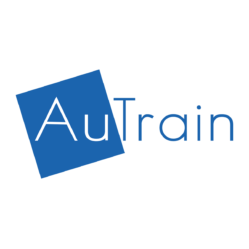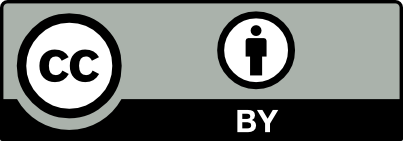09:30 – 10:15
Inclusion from different perspectives
Critical elements for creating an inclusive society
Activity: Think & Reflect 1.1 – inclusion
#4. Introduce the content -inclusion in the community – by reading the following text out load. In the end, ask for comments, doubts, or questions
Note: Present slides number 9 to 12
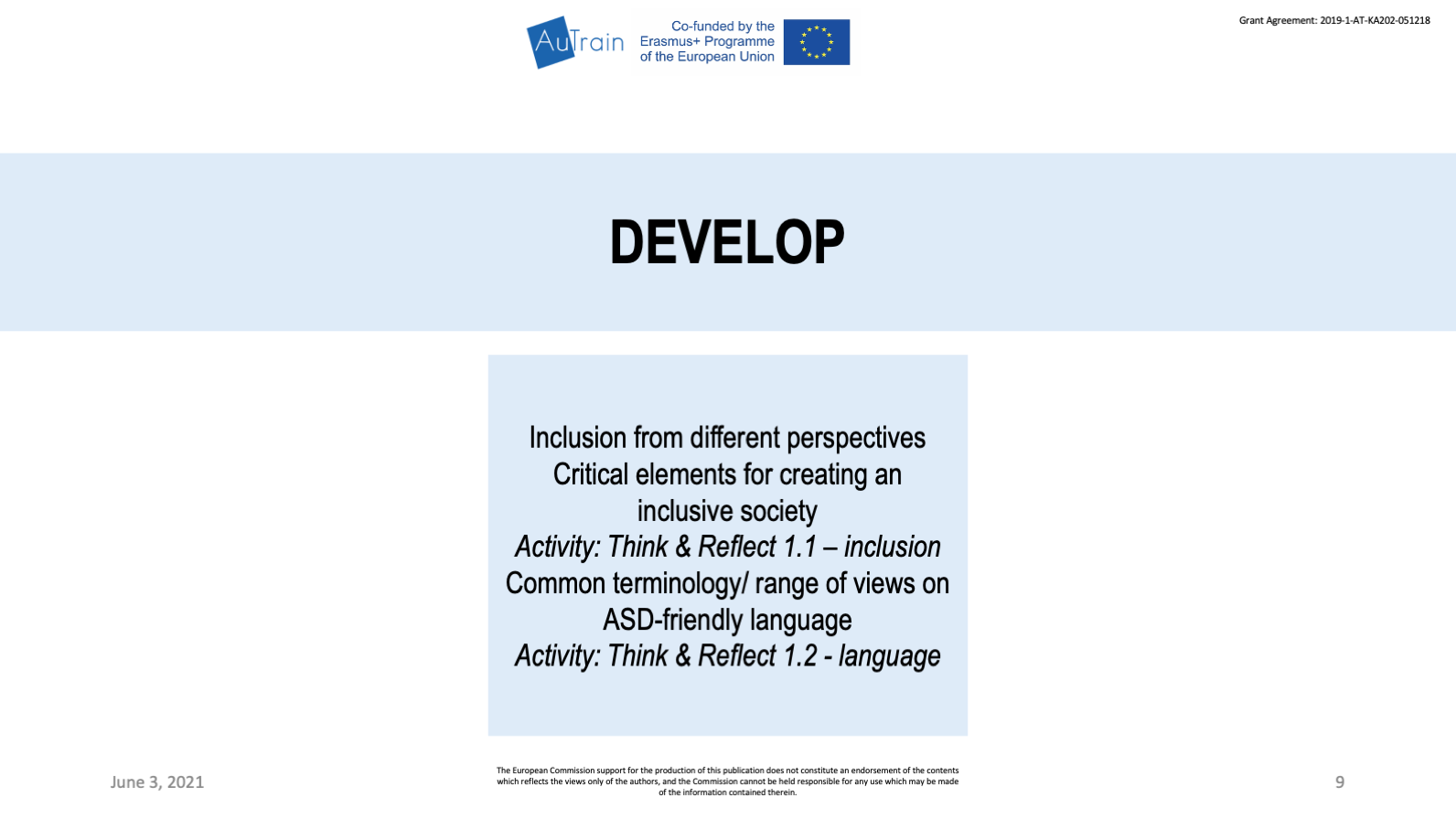
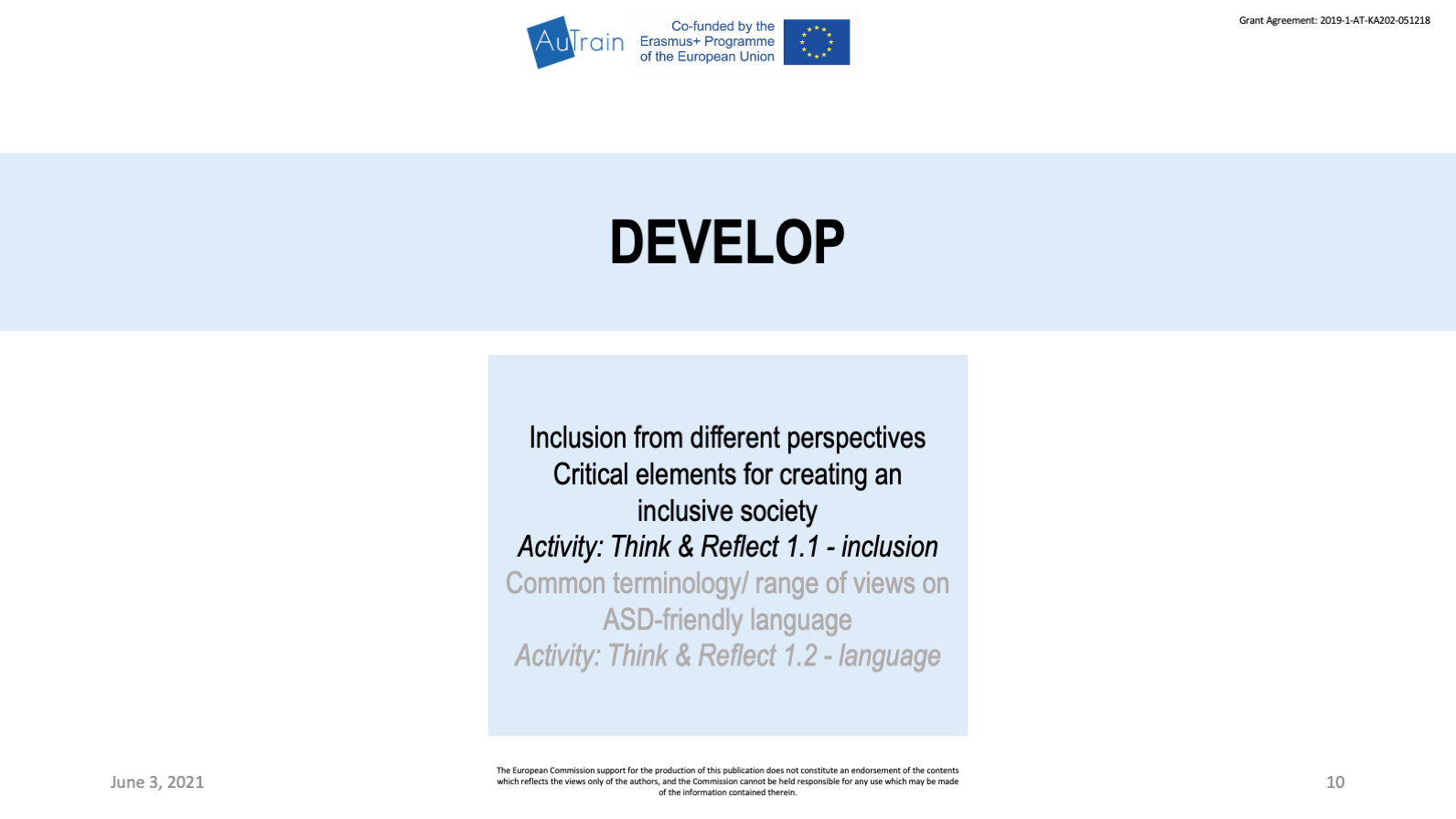
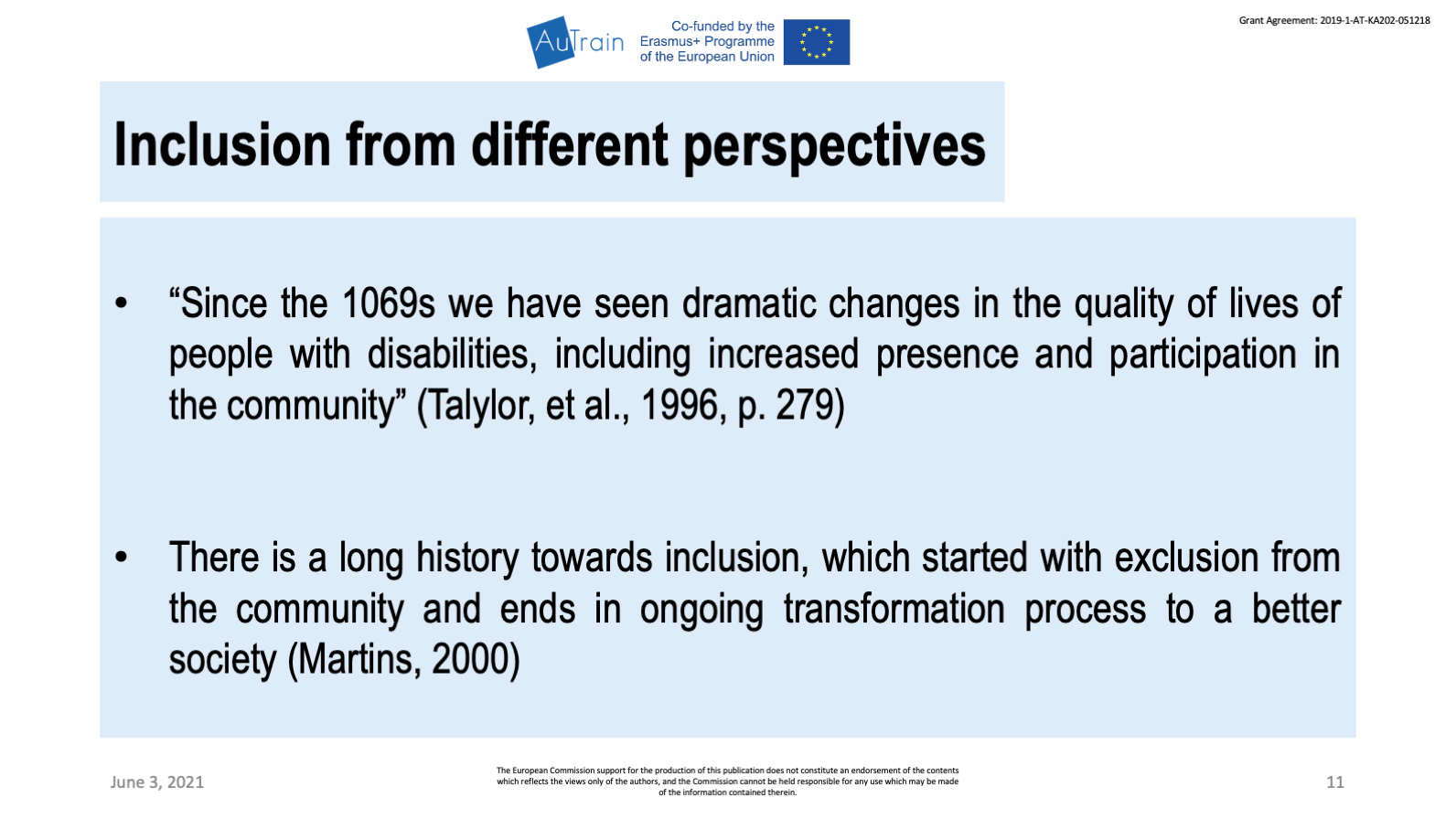
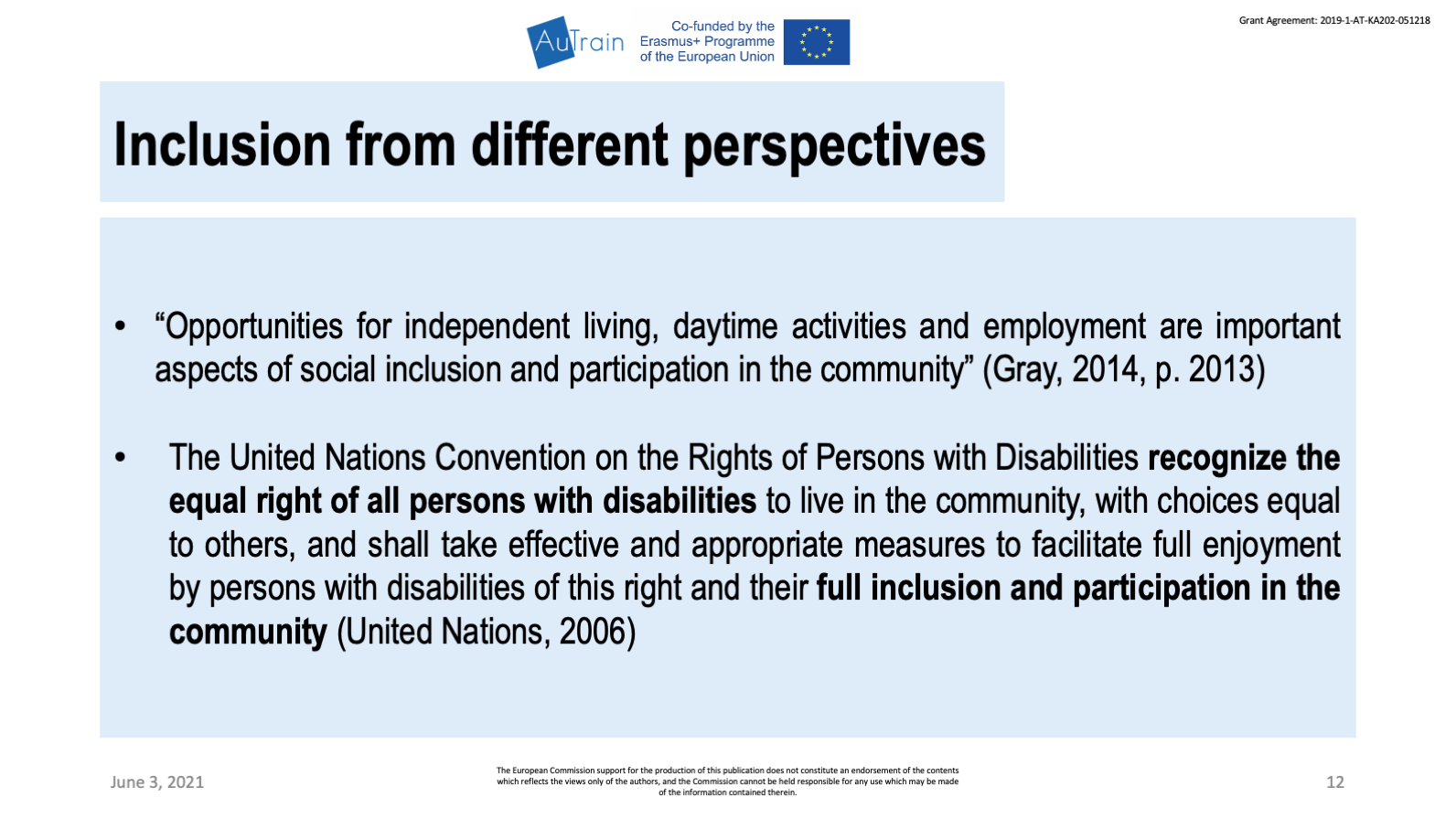
“Since the 1069s we have seen dramatic changes in the quality of lives of people with disabilities, including increased presence and participation in the community” (Talylor, et al., 1996, p. 279).
- There is a long history toward inclusion, which started with exclusion from the community and ends in ongoing transformation process to a better society (Martins, 2000).
- “Opportunities for independent living, daytime activities and employment are important aspects of social inclusion and participation in the community” (Gray, 2014, p. 2013).
- The United Nations Convention on the Rights of Persons with Disabilities recognize the equal right of all persons with disabilities to live in the community, with choices equal to others, and shall take effective and appropriate measures to facilitate full enjoyment by persons with disabilities of this right and their full inclusion and participation in the community (United Nations, 2006).
Ask for comments or doubts, or questions
Note: Present slides number 13 to 15
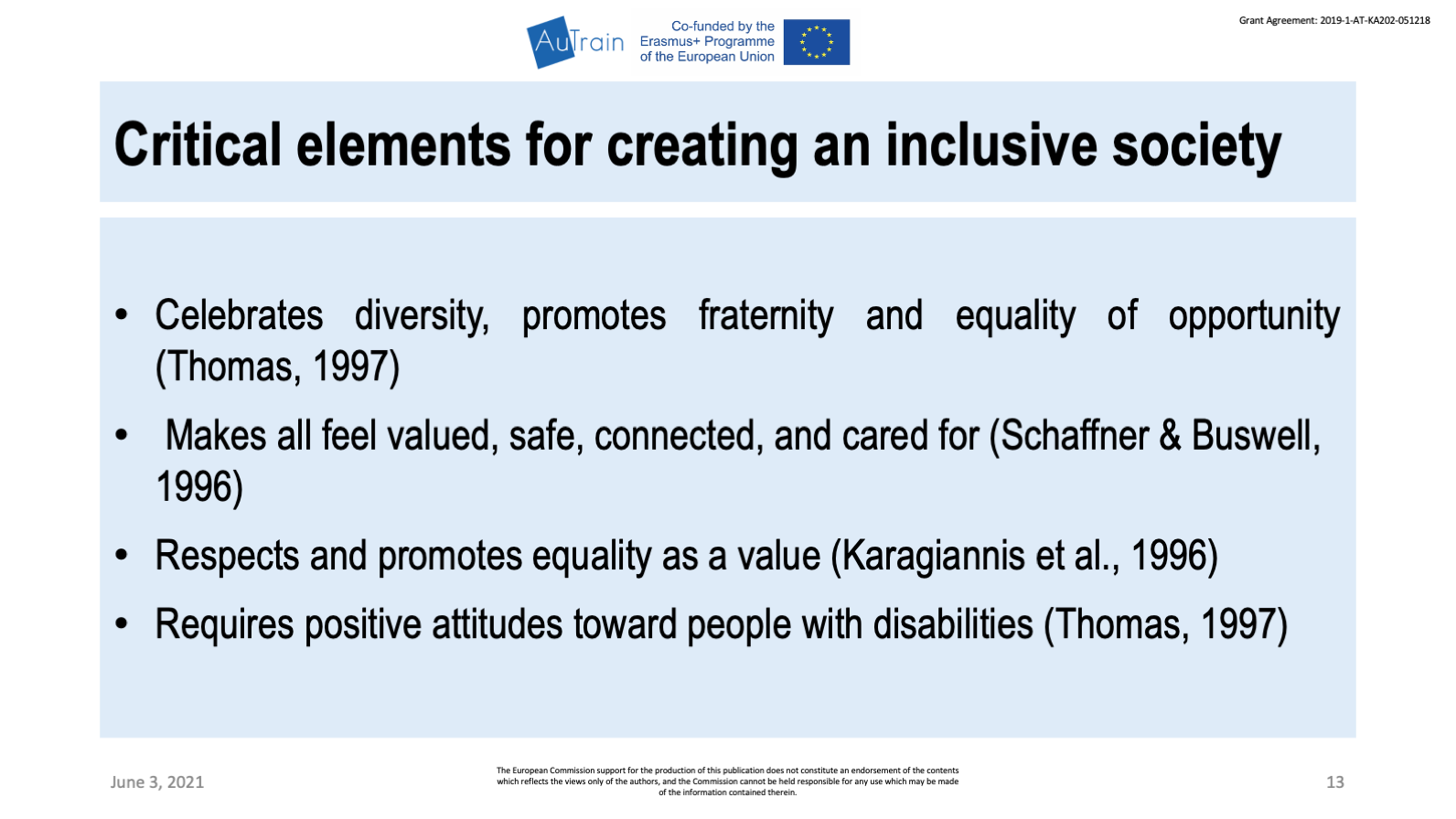
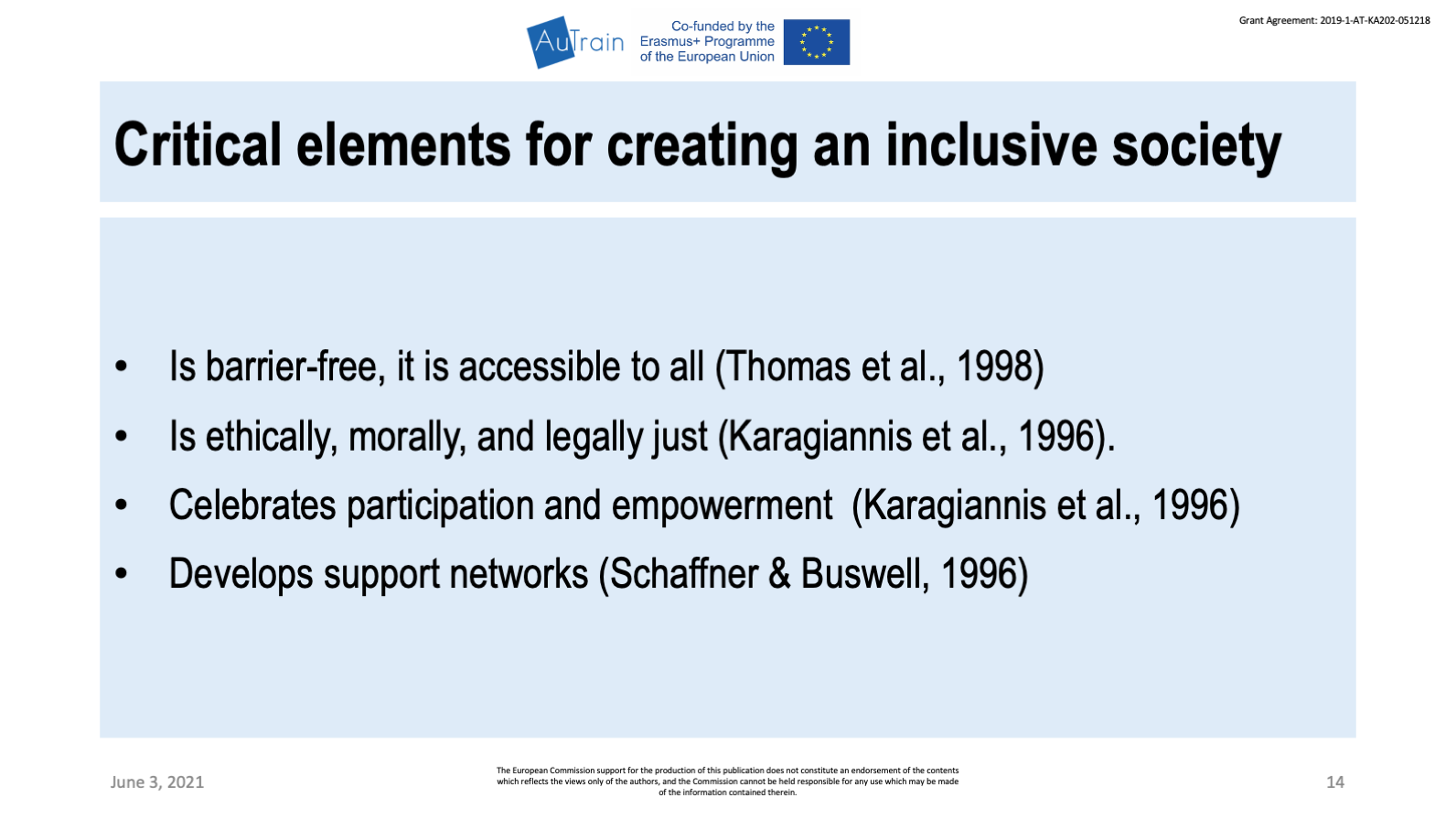
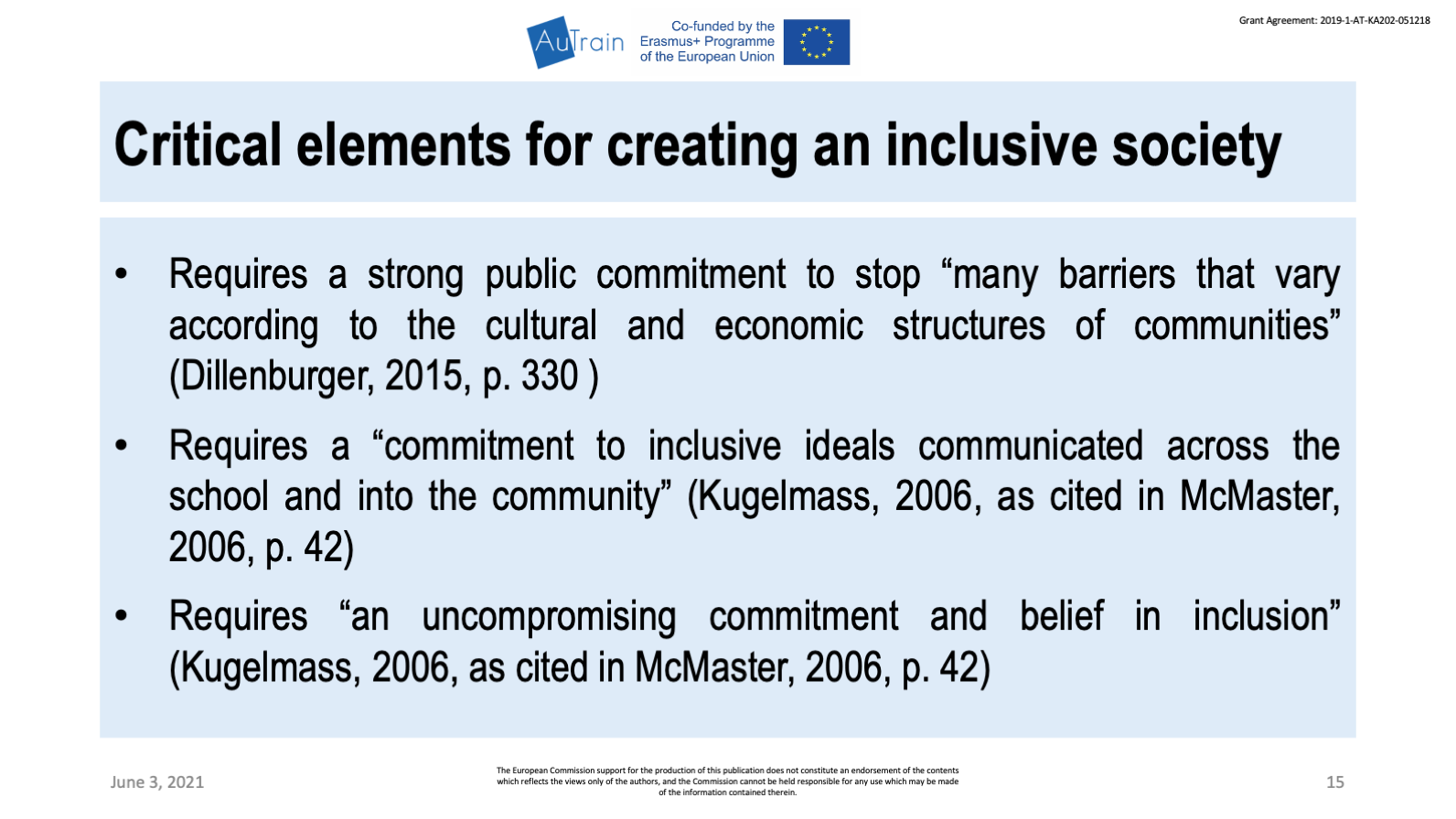
An inclusive society
- Celebrates diversity, promotes fraternity and equality of opportunity (Thomas, 1997).
- Makes all fell valued, safe, connected, and cared for (Schaffner & Buswell, 1996).
- Respects and promote equality as a value (Karagiannis et al., 1996).
- Requires positive attitudes toward people with disabilities (Thomas, 1997).
- Is barrier-free, it is accessible to all (Thomas et al., 1998).
- Is ethically, morally, and legally just (Karagiannis et al., 1996).
- Celebrates participation and empowerment (Karagiannis et al., 1996).
- Develops support networks (Schaffner & Buswell, 1996).
- Requires a strong public commitment to stop “many barriers that vary according to the cultural and economic structures of communities” (Dillenburger, 2015, p. 330).
- Requires a “commitment to inclusive ideals communicated across the school and into the community” (Kugelmass, 2006, as cited in McMaster, 2006, p. 42).
- Requires “an uncompromising commitment and belief in inclusion” (Kugelmass, 2006, as cited in McMaster, 2006, p. 42).
Ask for comments or doubts, or questions
#5. Introduce and develop the Activity: Think & Reflect 1.1 – Inclusion
Note: Present slides number 16 (the image has an automatic link to the video) while you are introducing the activity and showing the video; While participants are developing the activity project slide number 17. )
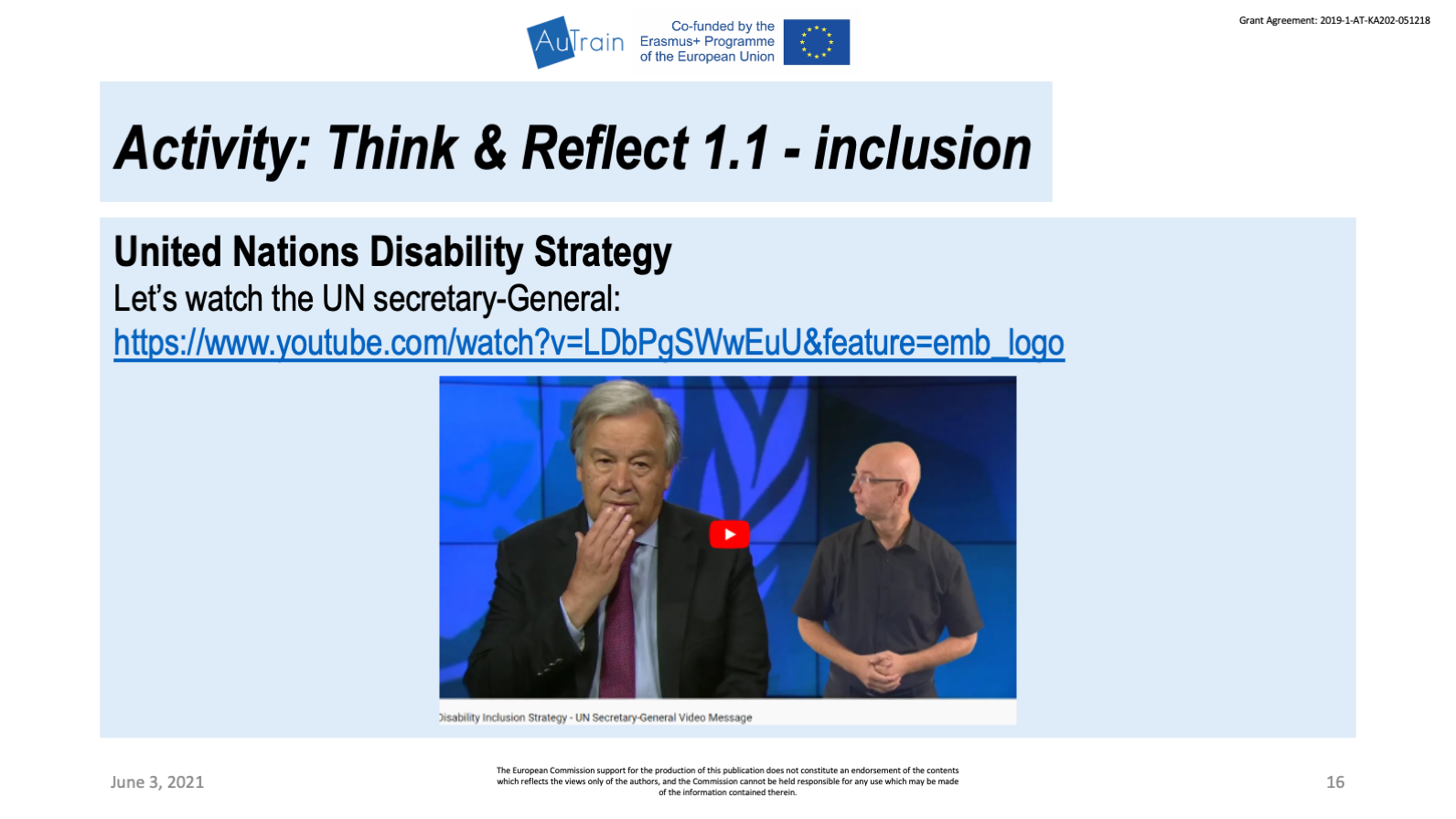
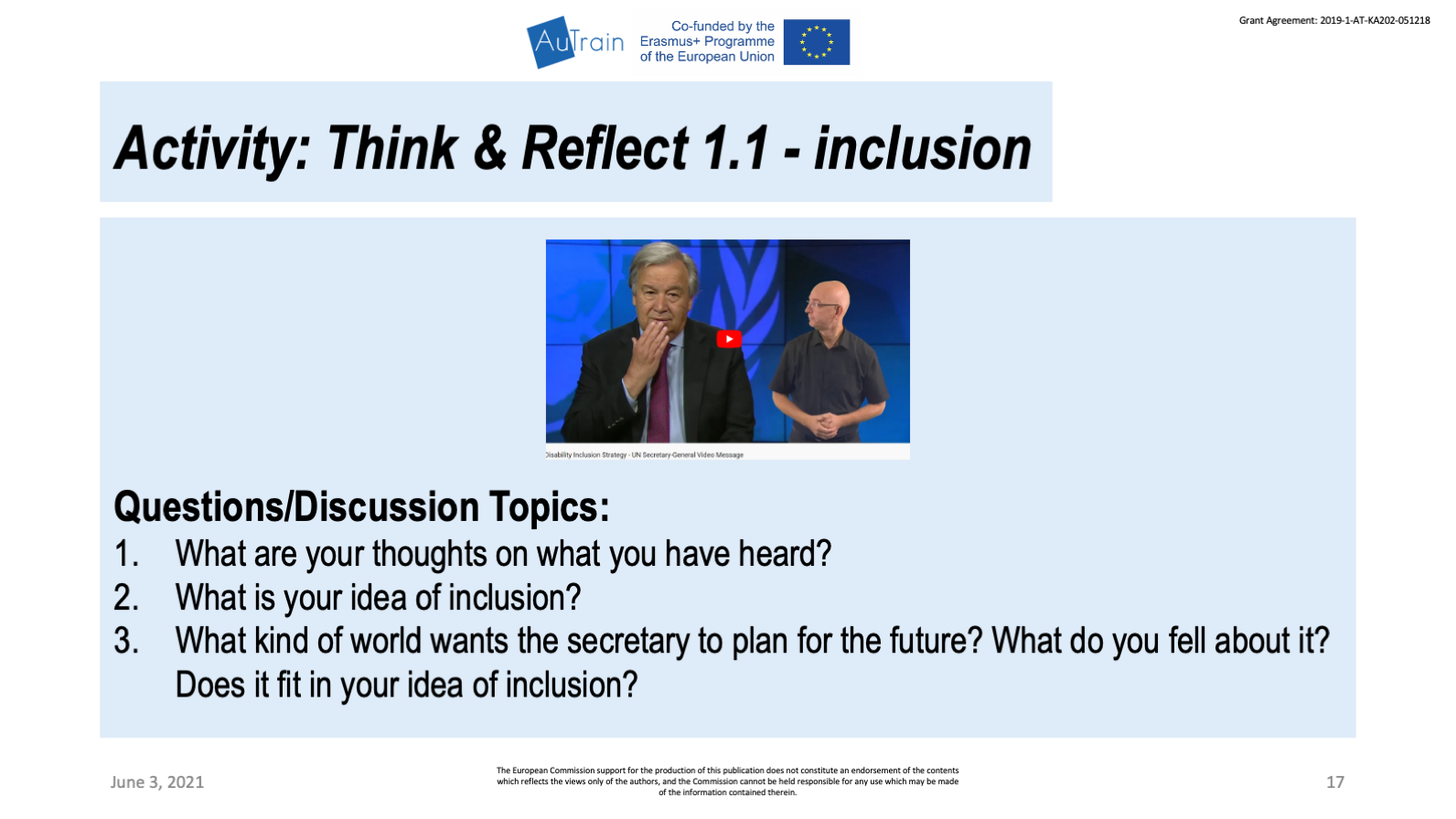
Introduce the aim of the activity
We will watch a 1 minute and 10 seconds video of The United Nations secretary talking about the United Nations Disability Strategy. After that we will reflect about our perception of inclusion throughout the words of The United Nations secretary. We will be organized first in small groups of 3 /4 participants and after the discussion we will open to all group.
Introduce the material: Pass out the Worksheet “Think & Reflect 1.1 – Inclusion” and be ready to show the video (use the link in the slide or the following link.)
Procedures
a. Form small groups of 3 /4 participants. Let participants form the groups, which can also help participants get to know each other better, but feel free to find other way; keep your options fluid and flexible.
b. Ask participants to be prepared to discuss the questions presented on the worksheet after the video be watched. Read the questions and ask for doubts or comments.
c. Inform participants that they will discuss it within their small group and after that they will report their ideas to the class. They should decide who will present the group ideas and discussion.
d. Show the video. To add subtitles with translation:
In the player, select Settings.Select Subtitles/CC – Add subtitles.Select Automatic translation – choose your language.
e. While participants are in small groups, you should act as a facilitator, moving from group to group. Doing so allows you to ensure that all of its members are actively participating and learning.
f. Participants share their best ideas with the class. Connect these ideas to the ones presented at the brainstorming activity.
Questions/Discussion Topics
a. What are your thoughts on what you have heard?
b. What is your idea of inclusion?
c. What kind of world is the secretary planning for the future? What do you fell about it? Does it feet in your idea of inclusion?
Adaptation for online session
After watching the video in the main meeting room,send groups to breakout rooms, and you move from room to room. Share the worksheet using the chat function.
#6. Summarize the message of the secretary of The United Nations and the participant’s ideas. In the end ask for comments, doubts, or questions
Note: Present slides number 1 8
To summarize the participants’ ideas, you can keep a record in the backboard of what is being shared. Reflect how the ideas are similar/different from each participant. To Summarize the words of The United Nations secretary use slide number 18.
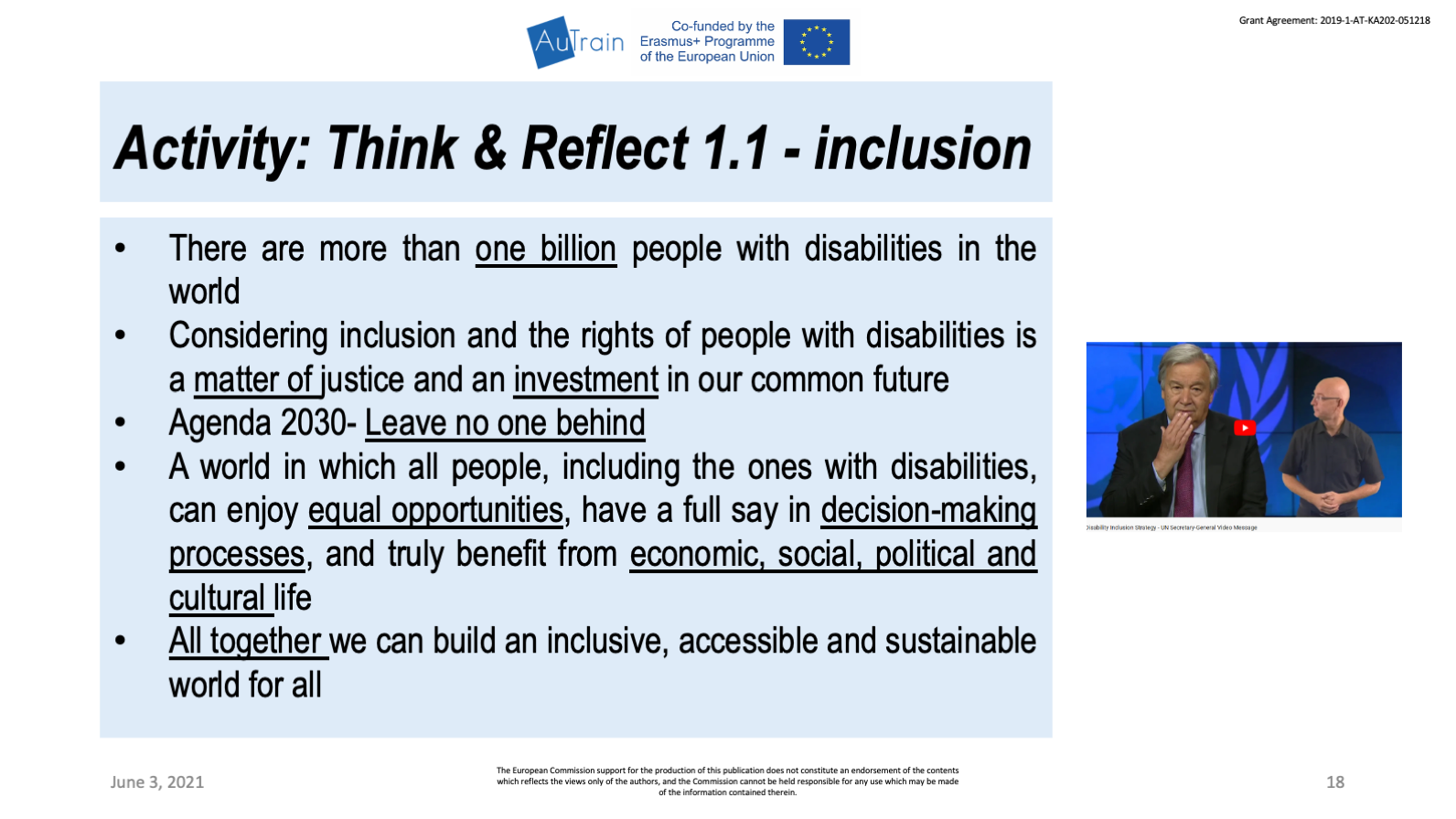
In summary, we can underline
- There are more than one billion people with disabilities in the world.
- Considering inclusion and the rights of people with disabilities is a matter of justice and an investment in our common future.
- Agenda 2030- Leave no one behind. A world in which all people, including the ones with disabilities, can enjoy equal opportunities, have a full say in decision-making processes, and truly benefit from economic, social, political and cultural life.
- All together we can build an inclusive, accessible and sustainable world for all.
BREAK TIME
10:15 – 10:45
#7. Introduce the content – Common terminology/ range of views on ASD-friendly language – by reading the following text out load. In the end ask for comments, doubts, or questions
Note: Present slides number 20 to 22
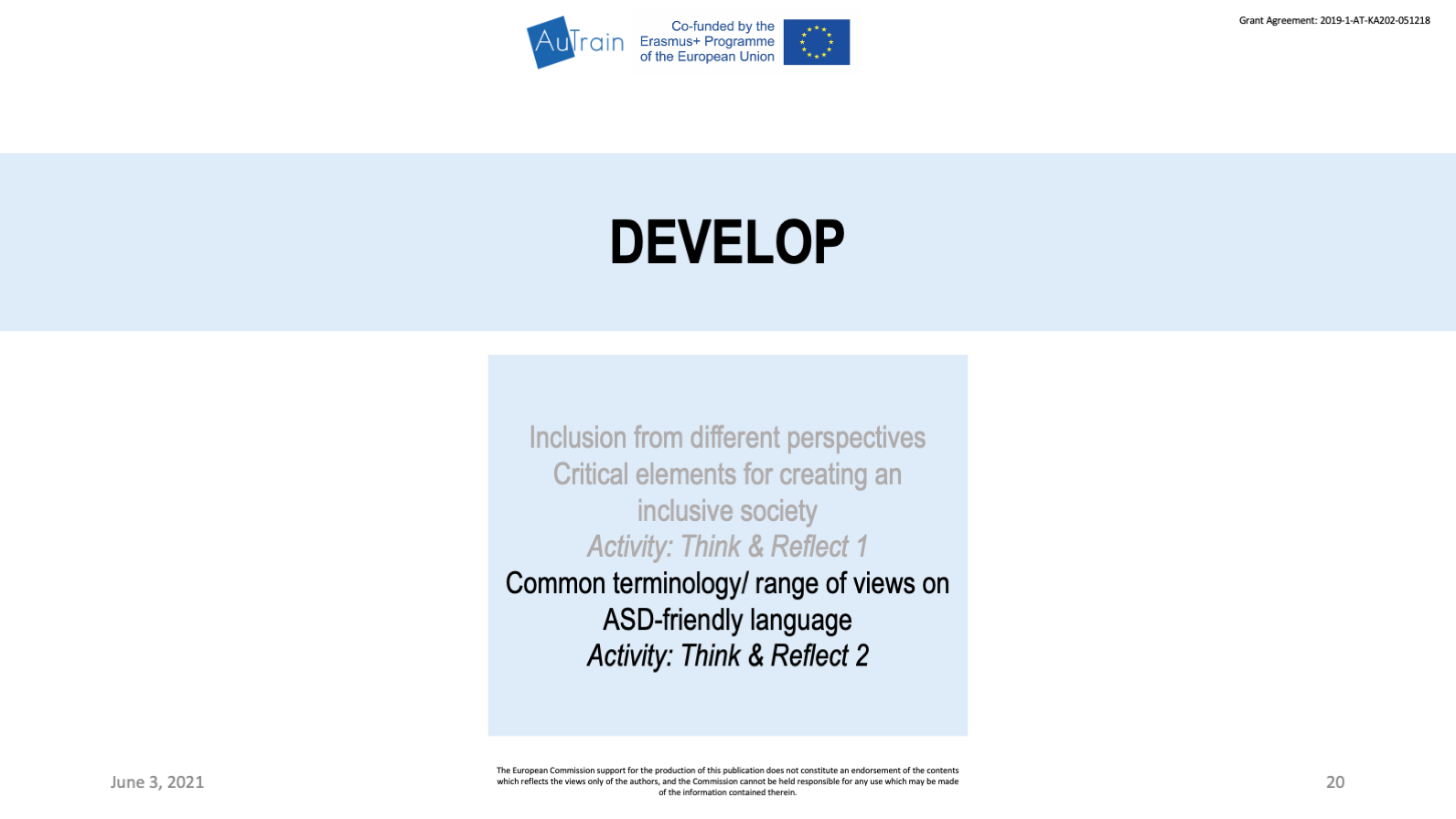
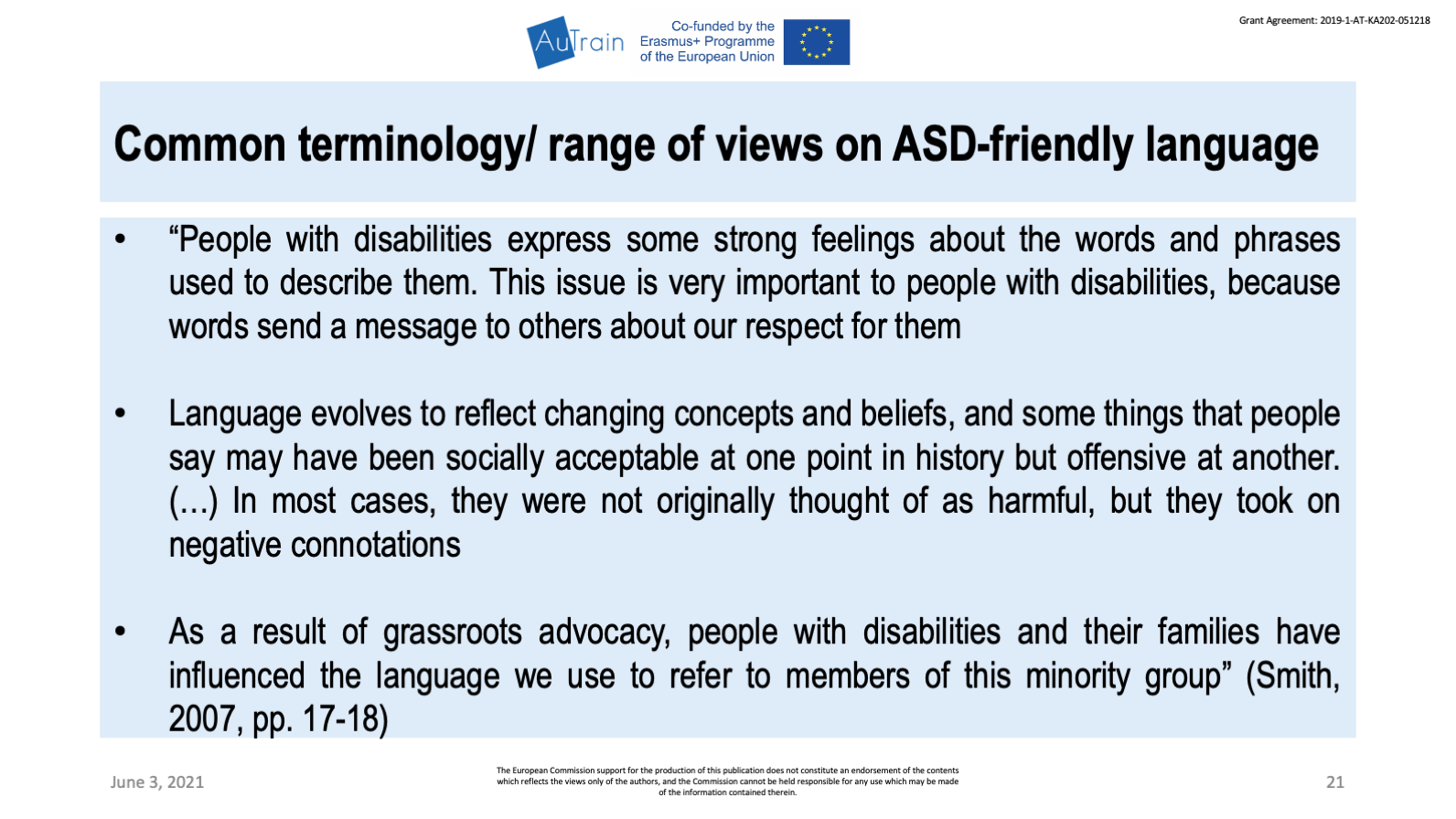
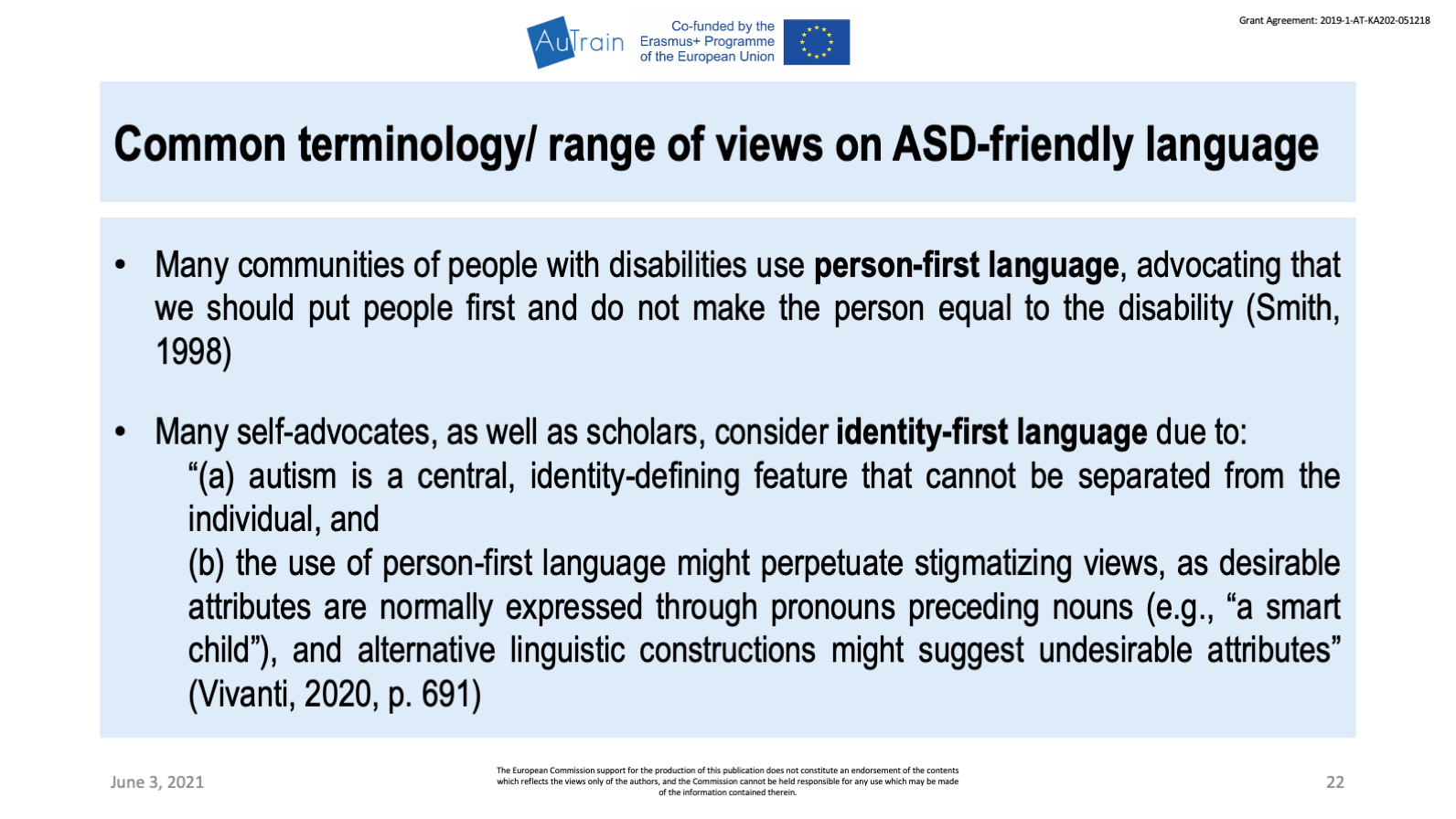
- “People with disabilities express some strong feelings about the words and phrases used to describe them. This issue is very important to people with disabilities, because words send a message to others about our respect for them. Language evolves to reflect changing concepts and beliefs, and some things that people say may have been socially acceptable at one point in history but offensive at another. (…) In most cases, they were not originally thought of as harmful, but they took on negative connotations. As a result of grassroots advocacy, people with disabilities and their families have influenced the language we use to refer to members of this minority group” (Smith, 2007, pp. 17-18).
- Many communities of people with disabilities use of person-first language, advocating that we should put people first and do not make the person equal to the disability (Smith, 1998).
Many self-advocates, as well as scholars, consider identity-first language due to:
“(a) autism is a central, identity-defining feature that cannot be separated from the individual, and
(b) the use of person-first language might perpetuate stigmatizing views, as desirable attributes are normally expressed through pronouns preceding nouns (e.g., “a smart child”), and alternative linguistic constructions might suggest undesirable attributes” (Vivanti, 2020, p. 691).
Introduce the aim of the activity
This activity aims to intoduce the discussion related to the proper use of language when referring to individuals with disabilities, and to identify the differences between Person and identity first language. First we will watch a short video of about the subject, and after that we will reflect and discuss about it in pairs and in the all group.
Introduce the material: Pass out the Worksheet “Think & Reflect 1.2 – Language” and be ready to show the video (use the link in the slide or the following link.)
Procedures
a. Form pairs. Let participants form the pars, which can also help participants get to know each other better, but feel free to find other way; keep your options fluid and flexible. For example, participants can turn to the person next to them, or you can place multi-colored dot stickers on the Worksheet. Participants form pairs with others who have the same color dot on their Worksheet 2. Be sensitive to learners’ needs when creating pairs.
b. Ask participants to be prepared to discuss the questions presented on the worksheet (the ones presented below) after the video be watched. Read the questions and ask for doubts or questions.
c. Inform participants they will be using the collaborative learning strategy Think-Pair-Share. This strategy requires participants to (1) think individually about the answers to the questions; and (2) share ideas with a pair and (3) share ideas with the large group. Discussing with a partner maximizes participation, focuses attention and engages students in comprehending the subject.
d. Show the video. To add subtitles with translation:
- In the player, select Settings.
- Select Subtitles/CC – Add subtitles
- Select Automatic translation – choose your language.
e. Individual work.
f. Pair work extending on individual work. While participants are working individually and in pairs, you should act as a facilitator and a supporter, moving from pair to pair. Doing so allows you to ensure that all of the participants are actively participating and learning.
g. Expand the ideas shared by the pairs into a whole-class discussion. Allow participants to choose who will share with the whole group.
References of the Think-pair-share:
Questions/Discussion Topics
a. What thoughts did you have about these video with two different perspectives in what concerns friendly language?
b. What major models are linked to these two different perspectives in what concerns friendly language? Explain.
c. How important do you think it is that officers are aware of diversity of language when contacting people with ASD? Explain your answer.
d. How important do you think it is that officers use appropriate language when contacting people with ASD? Explain your answer.
Wrap up the activity by reading out load the following text. In the end ask for comments, doubts, or questions and provide feedback.
Note: Present slides number 25 and 26
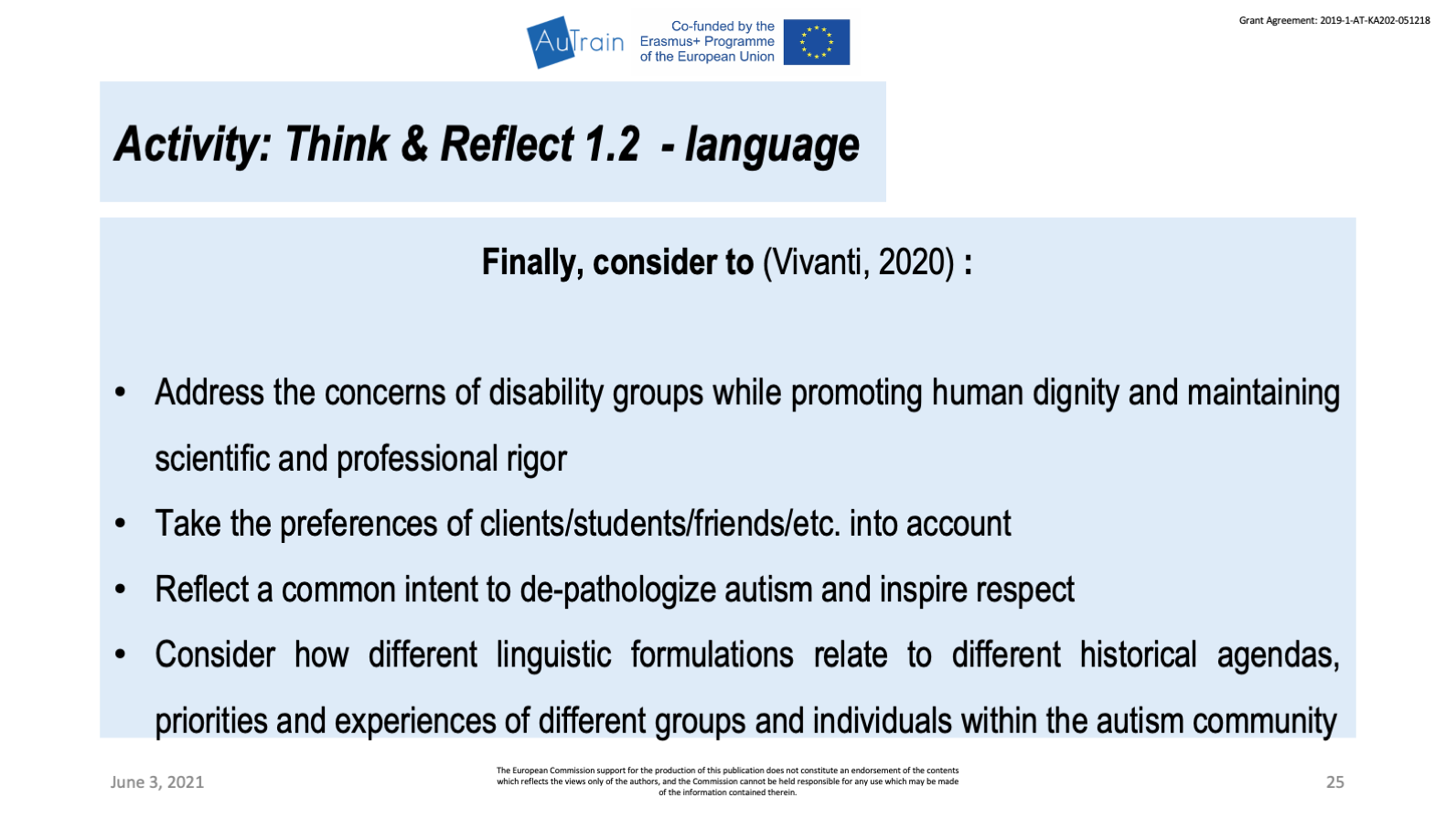
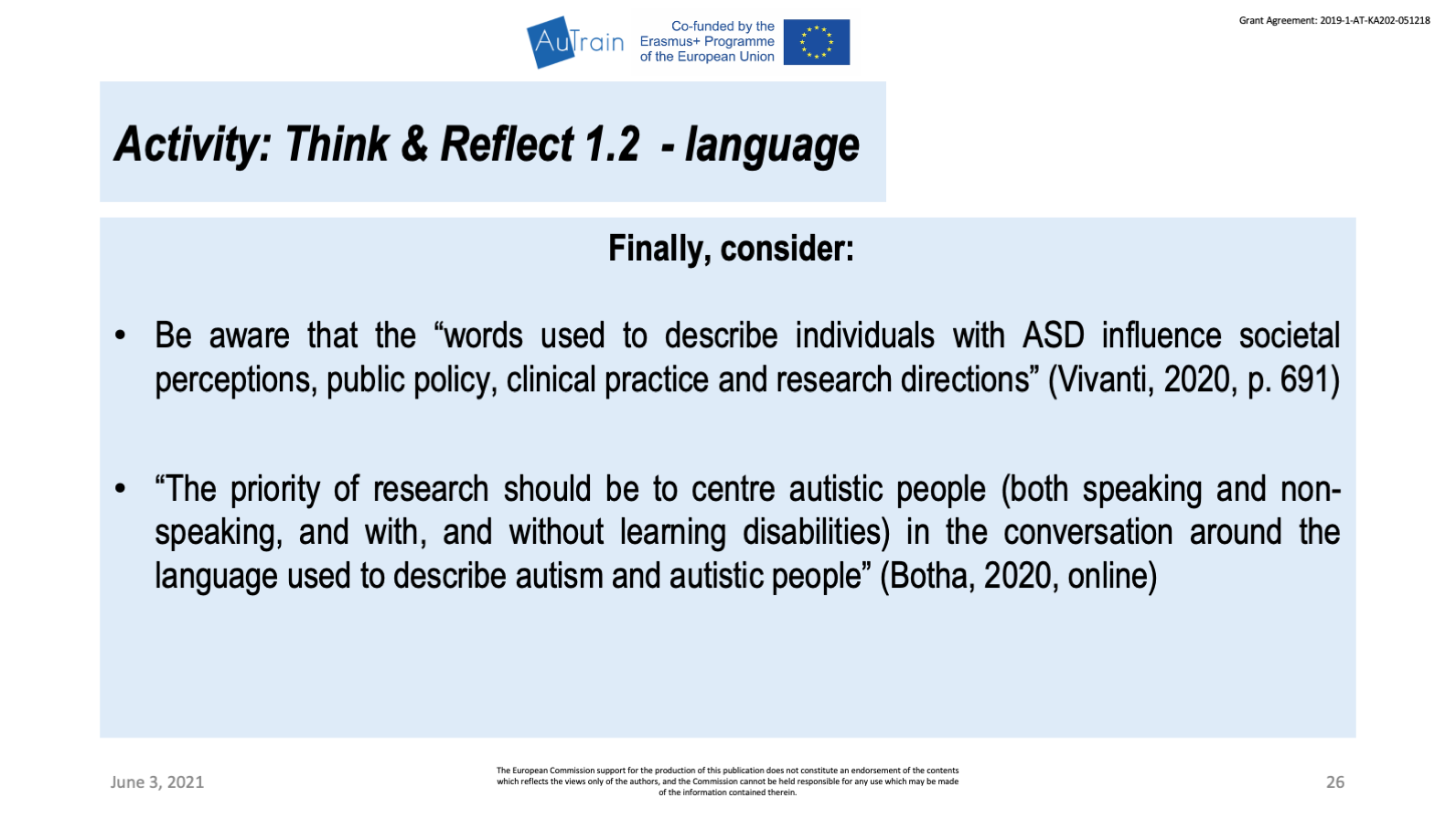
To summarize it consider
- Be aware that the “words used to describe individuals with ASD influence societal perceptions, public policy, clinical practice and research directions” (Vivanti, 2020, p. 691).
- “The priority of research should be to center autistic people (both speaking and non-speaking, and with, and without learning disabilities) in the conversation around the language used to describe autism and autistic people” (Botha, 2020, online).
